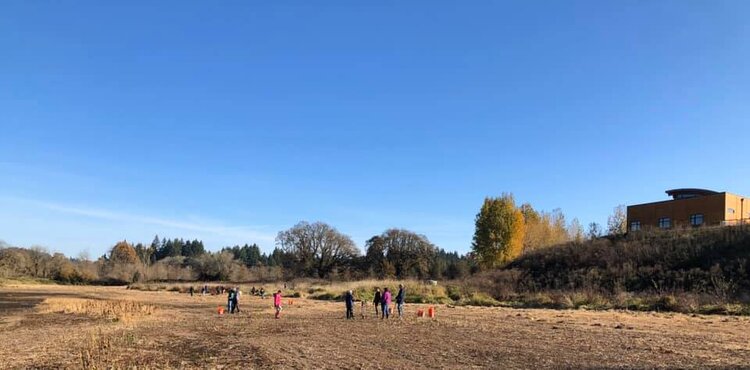Wetland Restoration
July 2019 marked the beginning of restoration for the permanent wetlands in front of the Refuge Visitor Center, referred to as 1P and 2P (P for Permanent, meaning water is present year-round). The project aims to restore native wetland vegetation to improve habitat for a variety of wetland-dependent wildlife. This includes brood rearing and wintering waterfowl, nesting marsh birds (e.g. sora and pied-billed grebes), pond breeding amphibians, and native pollinators. In addition, the wetlands may be suitable for western pond turtles and painted turtles.
Key Dates
Phase 1 – Mid-July through Late November 2019: The wetlands in front of the Visitor Center will be drained to begin habitat improvements and remove obsolete infrastructure adjacent to the wetlands. In November the Refuge and Friends group will host volunteer planting opportunities to plant native wetland vegetation such as wapato, native sedges, and native rushes.
Phase 2 – Spring 2020 onward: Evaluation and planning for additional restoration will occur.
Oak Woodland Restoration
Oak habitat and regional oak conservation
Oregon white oaks provide important habitat and food sources for many wildlife; in addition to nesting sites for birds, these trees also provide den sites for mammals, unique habitat for mosses and lichen, and are home to hundreds of species of insects. Oak woodland habitat has been significantly reduced throughout the Willamette Valley due to agriculture and development. There has been considerable efforts throughout the region to restore oak woodland, oak savanna, and other oak habitat.
Project background and current management
The oak woodland is an approximately 5 acre site, off of the year-round trail, adjacent to the Visitor Center. The space is currently dominated by Oregon white oak, with an understory comprised mostly of non-native species such as reed canarygrass, meadow foxtail, and other noxious weeds. In the summer of 2021, the oak stand will be thinned (trees will be removed) in order to improve the health and survivability of the remaining trees.
Oak Woodland Thinning Project
When: End of July 2021
What: Select Oregon white oak trees that have been inspected by our biology team will be removed from the oak habitat area, off of the year-round trail
Why: When this site was first planted about 15 years ago, management likely anticipated a high mortality rate for the young white oak trees; however, the majority of trees planted have survived, which has resulted in a dense stand. If left unmanaged, individual trees in this area are more likely to be less “healthy” (e.g. reduction in growth rate, more susceptible to disease, limited acorn production) due to higher competition for nutrient and light resources. Moving forward in the management of this site, the removal of oak trees and thinning of the stand is necessary to improve the health and survivability of the remaining trees; this action will also help in the continuation of overall site restoration
Where: Oak woodland site off of the year-round trail
How will this affect visitor experience?
Portions of the year-round trail may be temporarily closed, but our seasonal trail will remain open. While we anticipate a very temporary closure (1-2 days), we ask that visitors please respect the closed area during restoration
Partnerships have made this project possible
The Friends of Tualatin River National Wildlife Refuge acquired $25,000 in funding to complete the restoration of these essential permanent wetlands. The Friends will be hosting volunteer planting opportunities throughout the project in order to provide the community a vested opportunity for restoration on the Refuge. Ash Creek Forest Management, LLC will complete wetland planting after the volunteering plantings take place during November 2019 and April 2020.
Frequently Asked Questions
Where is the water in the wetlands?
The water was drained in July 2019 to allow for the removal of obsolete infrastructure, and provide access to the wetland to plant native vegetation.
When will the wetlands be filled with water?
The current projection is summer 2020. It was determined that the water will remain drained for winter 2019/2020 to allow approximately 15,000 native plants to take root as well as seed to germinate in the wetland bottom in the lakebed.
Where will all of the birds go?
They will seek out other wetlands in the area throughout the fall and winter likely move to other wet areas throughout the winter. Some other places to find waterfowl locally include: Jackson Bottom Wetlands, Fernhill Wetlands, Sauvie Island, Ridgefield National Wildlife Refuge, the Tualatin River, and nearby flooded fields.
